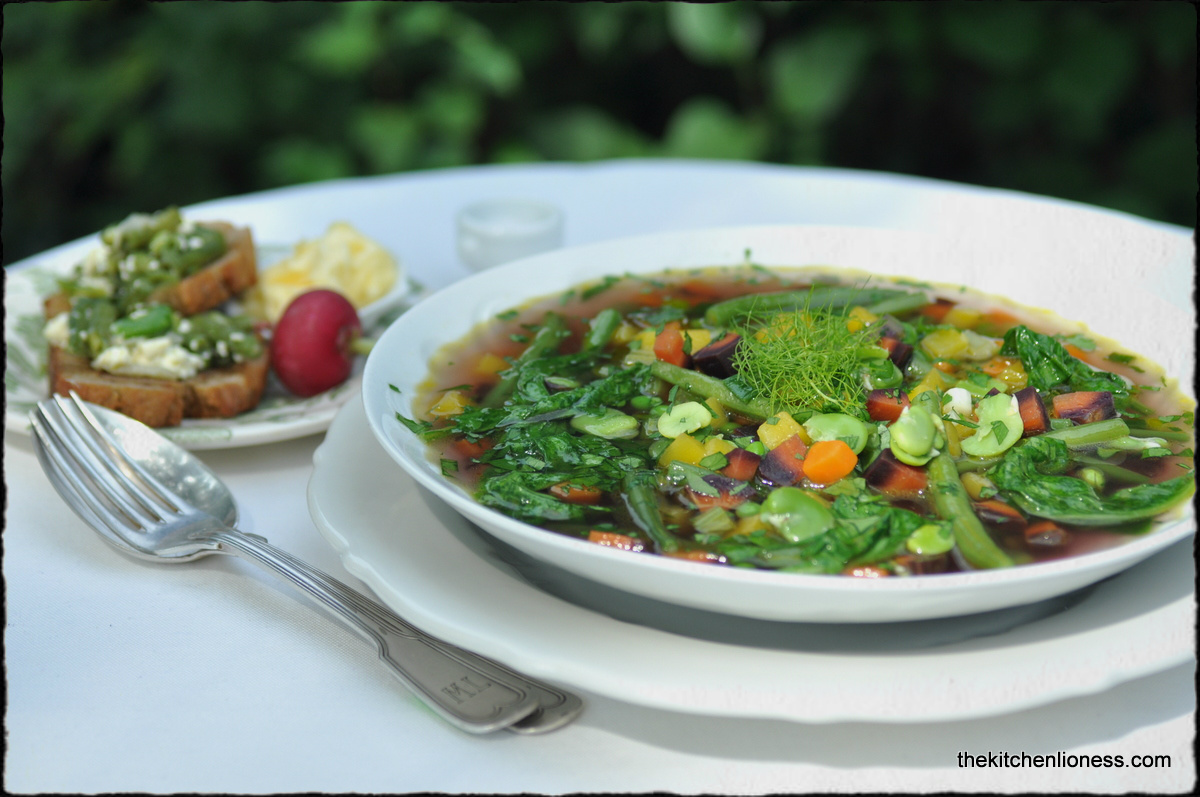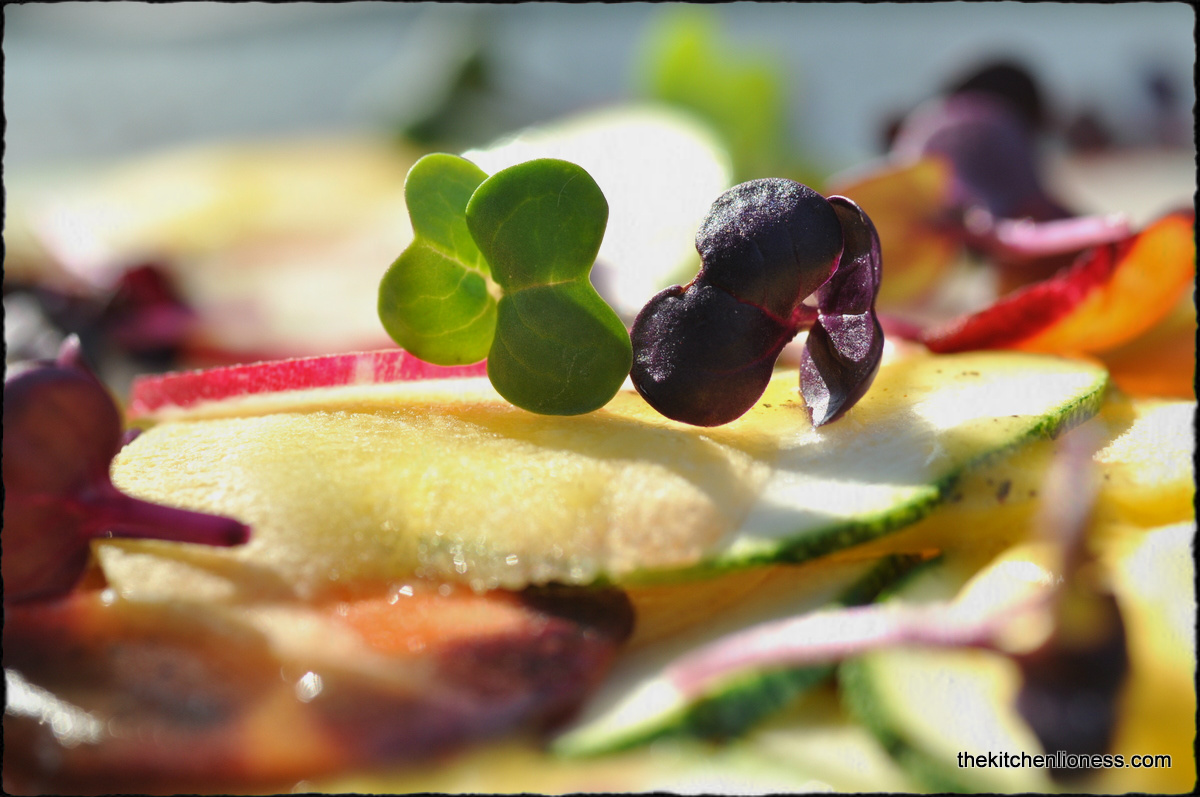Today, marks the third month of our international online cooking group, the Cottage Cooking Club.
As a group, recipe by recipe, we are cooking and learning our way through a wonderful vegetable cookbook written in 2011 by Hugh Fearnley-Whittingstall, called „River Cottage Everyday Veg“.
The Cottage Cooking Club online cooking group is meant to be a project aimed at incorporating more vegetable dishes in our everyday cooking. And learning new ways to prepare tasty and healthy dishes, and sharing them with family and friends.
We will make an effort to use as much local, regional, organic and also seasonal produce as is resonably possible. With that goal in mind, during that month of July, I prepared a few wonderful dishes from the book and made my utterly devoted taste testers quite happy!
My first recipe for the July post is the „River Cottage Summer Garden Soup“. How can you not prepare a soup with such a lovely title - no matter how warm it is in my tiny kitchen during the summer months, there was no way I would pass up the opportunity to make this fabulous recipe.
This recipe is most certainly meant to showcase the best summer produce you can find.
The base for my colorful soup was a homemade vegetable stock (yes, it was homemade, for the recipe, please consult page 130). The unbelievably delicious summer vegetables I used for this soup were chopped fennel bulbs, celery stalks and spring onions. Then there were French beans and freshly shelled peas, white courgettes, broad beans, orange, yellow and violet carrots. I replaced the salad that the recipe calls for with baby spinach, used tones of Italian parsley for sprinkling and some fennel fronds as a finishing touch. - A dream in a soup bowl!
I paired this dream with the "Bruschetta with Broad Beans" that we are also cooking this month and the "Radishes with Butter and Salt", a recipe that we made two months ago.
Second up is one of my personal favorites from the book – the "Tomato, Thyme and Goat´s Cheese Tart" – anyone who knows me also knows that I am seriously in love with these kinds of tarts.
When I started my personal series last year cooking my way through this book, I made this recipe using mozzarella and basil (if you are interested you can take a look here) – this time I opted for the goat´s cheese as well as some thyme.
The base is puff pastry that gets „lined“ with garlic – I used two garlic cloves, young garlic, no papery skins yet and sliced them before topping the pastry with it. The rest of the topping is the best seasonal tomatoes you can get your hands on – I opted for large sweet cherry tomatoes and a good-quality goat cheese with just the right amount of saltiness and some fresh thyme from the garden – now I do not know which tart I like better, the Spring Onion Galette (if you are interested you can take a look here) or this one…be that as it may, I have prepared them many times, with variations as to cheese and herbs and they are always a huge hit with all my taste testers.
The third recipe goes so well with these kinds of tarts, especially the Tomato, Thyme and Goat´s Cheese Tart. Another winner, the Marinated Courgettes with Mozzarella.
Again, this is a recipe that I have prepared before and that I like to come back to often.
How can you possibly go wrong with pan-fried (grilled in my case) summer courgettes that you marinate with a fruity olive oil, fresh lemon juice and zest and a bit of young garlic and then gently toss with creamy buffalo mozzarella, freshly ground black pepper and a wonderful crunchy, medium coarse sea salt.
Let me indulge for a second here, I do not know whether you have had the distinct pleasure of taste testing different kinds of black pepper – may I say that I have, and I loved the taste experience. If you happen to have a wonderful spice merchant in your neighbourhood (and who doesn´t), why not buy a different, good-quality black pepper and use it in a recipe like this – just a suggestion. Black pepper should always be bought in peppercorn form and always be ground just before using. There are a myriad of black peppers to choose from and this is a perfect recipe to show off a different kind of black pepper, different from your everyday-kind-of-pepper.
The fourth recipe is yet another recipe where you can really showcase that wonderful summer produce – Hugh Fearnley-Whittingstall calls this „Shaved Summer Veg“.
You will be required to produce „wafer-thin“ slices of summer veg to prepare this „deliciously crunchy and gorgeously colorful salad“. For the dressing you need English mustard (I have made a habit of always using Dijon mustard in the recipes), clear organic honey, lemon juice, a light olive oil, sea salt and that freshly ground black pepper.
The vegetables I chose were kohlrabi, green and white courgettes, yellow, orange and violet carrots and little red radishes – I could not find fresh yellow beets for the life of me, impossible to get those around here but the colorful carrots and radishes more than made up for that fact. I added some red beet cress though – we enjoy the peppery sharpness of the cress together with the crunch of the shaved veg and that creamy, mustardy dressing.
So, now I am halfway through my recipes this month and I need a short break in order to contemplate the elderberries on my elder bush in our garden. Every time I look at them, they remind me of my beloved grand-mother and her garden and her elder bush and the syrup she used to make every year – it had the most amazing deep-burgundy color and was always kept downstairs (“im Keller“) until winter time when you needed a bit something healthy to boost your immune system. So there it goes – no recipe yet. Not that you really need another recipe though.
Onto the „green recipe“ for the month of July, namely the „Bruschetta with Broad Beans and Asparagus“ (or French beans in my case).
The recipe is for beans or asparagus – alas no more asparagus to be had anywhere – so it was French beans and lovely broad beans (the girls are getting to be real masters at cleaning and prepping them), together with spring onions and goat cheese. Instead of rubbing the grilled sourdough bread with garlic, I carefully sautéed some very thin slices of garlic and added them to the bean-cheese mixture.
No need to say more - we loved this recipe to crumbs and pieces.
The next recipe needed a bit of an experienced fresh-tomato-pasta-sauce-person. A bit. The amount of the tomatoes I used was way more than the recipe for the „Pasta with Raw Tomato“ calls for.
That´s when that lovely thing called „scale“ comes in handy – the 750 grams were quickly doubled at the store – no reason not to, they are abundant these days, so much so, you cannot not buy more than you need.
I used two kinds of tomatoes for the sauce. The bright red ones and my newly-found favorite kind for cooking and for making salads, the zebra tomatoes – these beauties hail from Belgium, Flanders to be exact and I am quite partial to that region anyways. But I digress. The recipe is otherwise quite nice and summery.
You make the summery sauce, using the skinned and seeded tomatoes (a bit of a mess, I must admit), more young garlic, chili, capers, sea salt, black pepper and a ton of torn, fresh basil leaves – I will admit to adding quite a bit of fresh oregano to the sauce – perfect. By the way, if you can get your hands on the tiny capers called Capperi di Lipari sotto sale, use these but make sure to rinse off the salt and dry carefully before using in this sauce. Lots of fresh herbs and delightfully pungent capers can make all the difference.
Instead of making the „Panzanella“ that most participants had signed up for, I opted for a recipe from last month, the „Lettuce, Spring Onion and Cheese Tart“. After all, we would like to have all thirty recipes done after the third month and this is definitely a recipe that I wanted to try.
Lovely pastry with butter, flour, salt and milk – no eggs. I chose my wonderful French tart pan with high edges – for the more dramatic look, of course.
The filling consists of little gem lettuce hearts – pan-fried. Then spring onions, cheese, fresh eggs, double cream, milk, pepper and salt (I added some freshly ground nutmeg). Definitely the most labor-intensive recipe but also certainly worth making.
I loved the use of pan-fried lettuce – I often throw lettuce in my wok or soup and certainly appreciate cooking with different kinds of salad. I did serve red currants alongside, yes, fruit – it was a wonderful change to the usual side salads these days and it added some wonderful tartness, not to mention color, to the plate – besides, the talented author of this book recently (October, 2013) penned another wonderful cookbook called „River Cottage Fruit Every Day!“. The recipes in that book combine fruits and berries with savory foods – I have tried a few recipes from that book and love the concept. Oh, the possibilities...
Speaking of savory, one more savory recipe to go. The easy-peesy „Chargrilled Summer Veg“. Of course, I would not be me if I had not made a lot of these before – the proof can be found here. And, yes, I did get a tad inspired by the recipe. You all know that I seem to have way too much time on my hands so I chargrilled white asparagus a while back and made an absolutely delightful Salad of Chargrilled White Asparagus with a Bacon and Caper Dressing with this. I do not think that I need to post a recipe for the dressing – just use your favorite dressing to make your chargrilled veg be part of your summer salads – we all have a favorite, I am sure.
So, in order to gild the lily with all those wonderful recipes, it was time to make some veg ice cream for dessert. I opted for the pea ice cream sans mint (being rather German not British) because I am totally crazy about peas and because two or three of my fellow CCC bloggers had already opted for equally intriguing sounding Chocolate Beet Ice Cream.
Who knew that my kids would absolutely adore fresh summer Pea Ice Cream?! This was the best – although a tad time consuming to prepare because I used fresh peas (no, not frozen, not canned or anything else). Now, I have made this twice – this time I did leave a bit of texture with tiny specks of incredibly bright green peas and served it with champagne currrants and the best pistachio oil I have ever tasted, ever. And, yes, I use the real pistachio oil, bright green, healthy, and all and from my local oil mill - not the pistachio-infused one. And, yes, I paired oil with ice cream.
We are in love. Unfortunately, none left.
Please note, that for copyright reasons, we do NOT publish the recipes. I would like to point out that you should make sure to follow the rules on this EVEN if you chose to change or adjust an ingredient or two or the title of the recipe. For more information on the participation rules, please go here.
To see which wonderful dishes the other members of the Cottage Cooking Club prepared during the month of July, please go here.















































